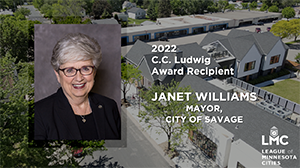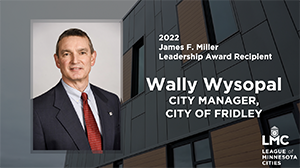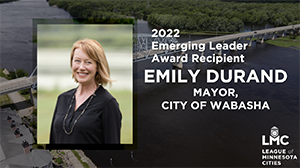League Recognizes City Leaders
 By Mary Jane Smetanka
By Mary Jane Smetanka
THE C.C. LUDWIG AWARD for elected city officials, JAMES F. MILLER LEADERSHIP AWARD for appointed officials, and the new EMERGING LEADER AWARD for city officials with less than eight years of experience were presented by the League of Minnesota Cities at the 2022 Annual Conference.
These awards honor individuals who have consistently done outstanding work to improve the quality of their own cities as well as cities throughout the state. The 2022 winners are Savage Mayor Janet Williams, Fridley City Manager Wally Wysopal, and Wabasha Mayor Emily Durand. To learn more about these award winners, watch the videos at lmc.org/awards22.
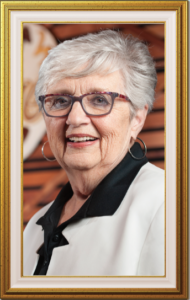
JANET WILLIAMS
SAVAGE MAYOR
C.C. LUDWIG AWARD WINNER
After 32 years of running the Scott County Public Library System, Janet Williams retired. A few restless weeks later, her husband told her she needed a job.
She aimed for public service instead, running for the Savage City Council in 2004. She won. In 2007, she ran for mayor and won again, becoming Savage’s first female mayor. After more than 14 years in office, she still likes it.
“I’ve always been interested in the city and county, and I believe you don’t sit around and complain; you do something,” Williams says. “I enjoy helping people and listening.”
Williams, 82, is passionate about her native Savage, which has grown from just 500 residents when she was a child to a city of over 33,000. Her deep roots in the community and determination have helped advance many important projects, including affordable housing and a mental health treatment facility.
Vision for the community
She works well with the public, making sure everyone has their say and working toward compromise on sometimes emotional issues.
When parents wanted to change the name of Savage Elementary School, it was no small thing to Williams, who is one of the founders of the local historical society. She explained who Savage was — an international businessman and owner of the famous racehorse Dan Patch — and the school kept the name but made it more specific. It became Marion W. Savage Elementary.
Williams is a strong leader who cares deeply about the city and gets things done, says City Administrator Brad Larson. Her constant interaction in the community makes her the eyes and ears of the city, reporting back on issues and concerns.
“Janet does all of this not for the accolades but because she has a vision for the community and works toward that vision,” Larson says. “She’s a mayor’s mayor. She grew up here and knows everyone and because she worked in the public sector, she understands policy, trusts staff, and lets them do their jobs.”
A proactive mayor
Williams is proud that Savage is “a city that plans and doesn’t react.” For example, Savage was the first Scott County city to get a Livable Communities Grant from the Metropolitan Council to help add affordable housing.
Another example of Williams’ proactive stance, Larson says, is that well before the issue of first responder mental health was widely discussed, she was instrumental in pushing the city police and fire departments to make mental health a priority.
She also advocated for first responder training in dealing with people who were having mental health issues.
Largely because of Williams’ interest in mental health — her first college degrees were in social work and psychology, and she has been a mental health advocate for many years — Savage partnered with the county and others to build a residential mental health treatment center.
The downtown facility opened about two years ago and added 30 jobs. Scott County no longer has to pay for expensive remote mental health placements for residents. Most of the patients at the Savage facility are local, Larson says.
There was almost no public pushback to the project. “Everybody knew Janet and knew she was an advocate for mental health. No one wanted to challenge her on that,” Larson says.
Building relationships
Williams also was an early champion of the Scott County Alliance for Leadership and Efficiency, a loose collaboration of local governments that explore how to better provide services and save money. Cities share specialized equipment and have joint contracts for projects like striping roads.
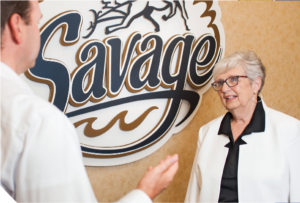
“It all comes down to relationships,” Williams says. “People don’t care who plows the road as long as it gets plowed.”
Williams has also encouraged women to get more involved in government. As library director, for years she was the only female department manager in the county.
Cities rely on public input, she says, and they need to hear from women, to get their perspective on issues.
City Council Member Christine Kelly says she is on the Council because of Williams. In 2008, she had two young children and, though she served on a city advisory group, she had no thoughts of running for higher office. Then Williams called.
“She said, ‘We need you,’” Kelly remembers. “She talked about service and giving back to the community…and how I could work with people and get something done. Talking to her on the phone, I changed my mind.”
Not slowing down
Williams says that even with her mayoral duties, she still reads a book every week and makes time for a weekly card game. “I have a triple-A personality,” she says.
She’s also thinking about resurrecting a pre-COVID tradition of inviting a dozen city employees to her home once a year for dinner. And she has no plans to stop being mayor of her beloved Savage.
“I’ve lived here my whole life,” she says. And when she thinks about how Savage has changed, she says, “I like to think I played a role in that.”
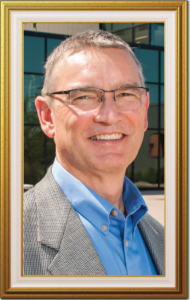
WALLY WYSOPAL
FRIDLEY CITY MANAGER
JAMES F. MILLER LEADERSHIP AWARD WINNER
At the tender age of 17 or 18, Wally Wysopal knew what he wanted local government to look like.
Not rude. Not dismissive. Even if the people who were looking for help were teenagers who just wanted a bonfire permit and fields mowed for softball games. Government should listen, he thought, and be friendly.
Wysopal got his bonfire permit, but he and his friends had to mow the softball fields themselves. That experience in a small Illinois town left its mark.
“I thought, there’s got to be a better way for government to serve its people,” Wysopal remembers. “I was among the very few who knew exactly what they wanted to do in high school.”
A kind and caring leader
Caring, respect, and a willingness to listen. Those are the qualities that Wysopal, 61, has brought to his job as Fridley city manager, say people who work with him. They describe him as kind, empathetic, supportive, and humble.
“People are happy to come to work here, and they stay a long time,” says Fridley Community Development Director Scott Hickok. Assistant Finance Director Korrie Johnson says Wysopal “has a teaching style of caring and growth. He wants to set you up for success.”

Wysopal is quick to deflect praise and won’t claim any achievements over his nine-year tenure except to say that he’s proud of how the mayor, City Council, and staff collaborate and give residents the time and respect they deserve.
Hickok says it’s telling that when Wysopal first arrived in Fridley, he asked why each city division had a mission statement, but the city as a whole did not.
It does now: To be a community that is a safe, vibrant, friendly, and stable home for families and businesses.
“He made that part of our brand,” Hickok says.
Wysopal got a degree in public administration from St. Mary’s University in Winona and a master’s degree in local government from Northern Illinois University. He came back to Minnesota, partly because his future wife lived here, and he worked in St. Louis Park and North St. Paul before becoming the city manager in Fridley.
Making needed changes
About four years ago, Wysopal faced one of his biggest challenges in trying to change a 1990s city charter provision that severely limited tax levy increases. City officials believed that in the long run, inflation and the need to modernize meant the city risked depleting its reserves.
“That was a challenge,” Wysopal says. “We were able to do the analysis and show we hadn’t been able to keep up with the challenges modern cities are facing. We had to build a case and share that with the Charter Commission and show that the trend would get worse. We couldn’t keep cutting back.”
For years, Wysopal has taught public administration at a couple of Twin Cities colleges. Hickok says Wysopal used those skills with the commission and “put on his professor hat,” lining up the numbers to show how those limits would hurt the city over time. “That’s Wally teaching,” Hickok says. “The commission ultimately agreed with him.”
Wysopal was also instrumental in making the case for a new Civic Campus to replace a deteriorating 1945 City Hall that had a leaky roof and was not accessible to people with disabilities. Repairing the old building would have cost tens of millions of dollars.
The $50 million Fridley Civic Campus opened in 2018 and houses City Administration, Public Works, and the Police and Fire departments. It has a pavilion for city events, including music in the summer. The project also included paths connecting to a trail system and a townhome development.
“It became a focal point for a city that doesn’t have a downtown,” Wysopal says.
Hickok says that in typical fashion, Wysopal never asked him where his office would be in the new building. “He said, ‘Put it where it makes sense.’ He found out where it was at the same time the rest of the staff did. He is very hands-off.”
In addition to his city manager duties, Wysopal is also executive director of the city’s Housing and Redevelopment Authority. In that role, he shepherded the redevelopment of 122 polluted acres. Though the city manager credits innovative developers and others for redeveloping the site, Hickok says Wysopal “played a huge role” in navigating the early stages involving financing and brownfield cleanup.
The site, now an industrial park called Northern Stacks, opened in 2016. The redevelopment has increased the site’s value from $14 million to more than $140 million, and includes manufacturers as well as a brewery and a wedding venue.
Ready for the next project
The city’s next big job is to implement a new master plan for its park system. The city asked residents what they wanted, and will spend $30 million to update parks, including upgrading playground equipment and adding trails. Wysopal is looking forward to that, as well as other challenges.
“I absolutely love working here,” he says. “The relationships are fun, the work is challenging, and it’s rewarding. I’m blessed to be here.”
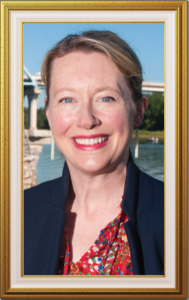
EMILY DURAND
WABASHA MAYOR
EMERGING LEADER AWARD WINNER
Emily Durand came to Wabasha in 2012 as the wife of the town’s new dentist, with a family and a demanding job that required a 170- mile round-trip commute to Bloomington.
But she found time to get involved in her new city. She joined the Heritage Preservation Commission, a school advisory board, and the boards of the United Way, Wabasha Area Food Share, and The National Eagle Center. Then, to her surprise, she was drafted to run for office. In 2019, she became Wabasha’s first female mayor.
It was a remarkable achievement in the old Mississippi River town of 2,600, where after a decade, Durand is still seen as a relative newcomer.
“We came here as hopeful new business owners, and I knew I wanted to be involved,” she says. “I came from a super small town where things don’t happen unless people participate.”
Newcomer turned mayor
Durand, 44, eventually left her job in Bloomington, but still has plenty of outlets for her energy. Her proactive thinking and creativity have vaulted her into a leadership role that has greatly benefited Wabasha, says City Council Member John Friedmeyer.
“She’s become very invested in the community,” he says. “She’s a project manager by nature and has taken all those skills, all that education, and done a really good job to help guide this community into the future. You walk into City Hall and the vibe is incredible.”
Durand had no intention of becoming mayor. But when the city’s previous mayor decided not to seek reelection, he urged her to run.
“I thought he was out to lunch; I had too much going on,” Durand says. But no one else was on the ballot. “He said, ‘We can’t not have someone run for mayor.’ And I thought, I can make this work, knowing the City Council and the good city staff.”
And the consensus is, she’s making it work quite well.
“She’s wonderful. I don’t think you could find a better person to work with,” says City Administrator Caroline Gregerson. “She’s good at educating citizens and explaining things, she’s there to support staff, and she’s always prepared. She understands the challenges of government.”
Early successes
Durand had barely taken office when controversy erupted over the U.S. Army Corps of Engineers’ plans to store tons of sediment dredged from the river near a residential neighborhood. During hauling season, an estimated 70 trucks an hour would have passed by homes. Residents were up in arms.
“We saw it as a major threat,” says Friedmeyer, who is president of the City of Wabasha Port Authority. Working with state and federal officials and attorneys, Durand helped coordinate an agreement that dumped sediment at a more remote location. The corps agreed to pay a tipping fee to the port authority to manage the material, giving the city additional revenue.
Durand “recognized the issue immediately, took point, and ran with it…and got us to a solution,” Friedmeyer says. “It’s a huge relief.”
He also credits Durand for building public support to advance the Eagle Center’s state bonding request. The city is a partner in the $23 million expansion project, making land available for an amphitheater. A public dock on the river for larger boats is also part of the project.
Tackling additional challenges
The Eagle Center is a boon for Wabasha, drawing 80,000 visitors a year. But the city faces the same challenges as other small towns. Residents are aging, school enrollment is dropping, and the city needs new and diverse types of housing and more support for child care.
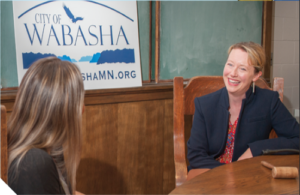
Before she was sworn in, and with the blessing of her predecessor, Durand applied for a grant to work with the University of Minnesota’s Center for Design on smallcity community development. Wabasha won the grant, and worked with university experts and students on a plan to reroute Highway 60 because of safety and flooding concerns. The city got a state grant to relocate athletic fields that often flood, and the straightened highway should be safer and allow commercial and residential development in an area that was little used.
“This project was talked about for 30 years, but Emily got the plan going,” Gregerson says. “I think we will get it done within five years. Thoughtful and creative urban design is new for us.”
Durand says the grant program is valuable for small towns because it focuses on “asset-based community development — working with what you have instead of what you don’t have.” While she says the Highway 60 project is “a big lift,” it will create housing and green space and contribute to pedestrian- friendly development.
That fits with Durand’s goal to make her city better for all residents. “We have to accept our demographics,” she says.
The city’s population is aging, and those residents need a housing option so there can be a transition. At the same time, Wabasha doesn’t want to have children leaving the schools because their families can’t find a place to live.
“Small communities cannot stay exactly the way they are,” Durand says. “They need to think creatively.”
Mary Jane Smetanka is a freelance writer.


